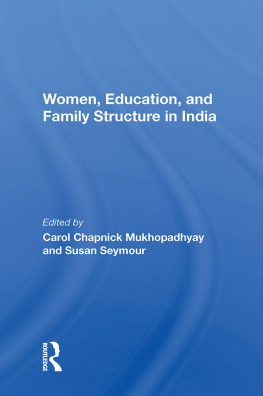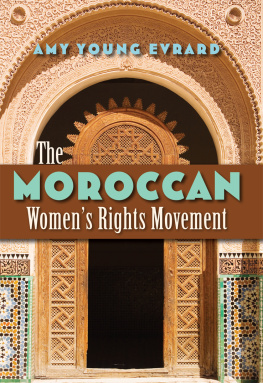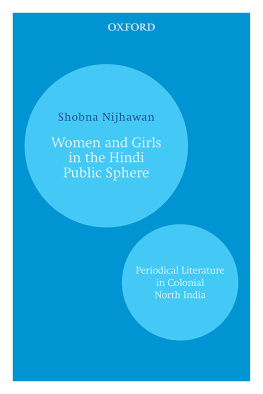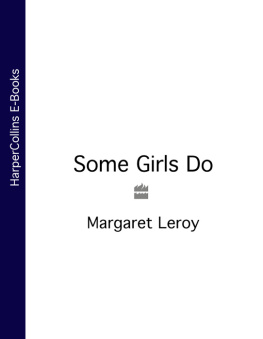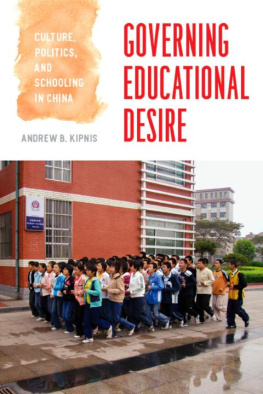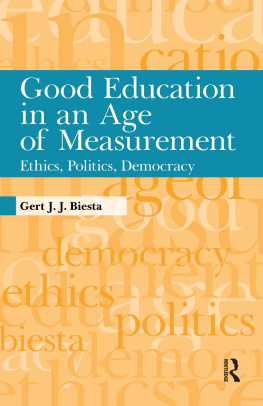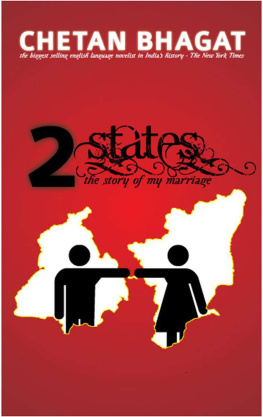Women, Education, and Family Structure in India
Praise for
Women, Education,
and Family Structure in India
"Based on fresh field data and offering a striking longitudinal view of links between women's education and family structure, this book is important reading for scholars of comparative gender studies, comparative education, social change, and South Asia. The contributors' findings show that even though patriarchy co-opts women's education and roles, education still can make quite a big difference between two generations."
Barbara D. Miller
The George Washington University
"Interesting and useful.... This book will be well received and widely quoted."
Alan Beals
University of California-Riverside
"A well documented, well written, theoretically significant work. The approach taken by the editors and authors harnesses historic and ethnographic, quantitative and qualitative data to examine the interaction between macro-level social processes and institutions and micro-level decisions and actions. This book will be of interest and of use far beyond the realm of Indian studies."
Patricia J. Higgins
SUNY-Plattsburgh
Women, Education, and Family Structure in India
edited by
CarolChapnickMukhopadhyay
andSusanSeymour

First published 1994 by Westview Press, Inc.
Published 2021 by Routledge
605 Third Avenue, New York, NY 10017
2 Park Square, Milton Park, Abingdon, Oxon OX14 4RN
Routledge is an imprint of the Taylor & Francis Group, an informa business
Copyright 1994 Taylor & Francis
All rights reserved. No part of this book may be reprinted or reproduced or utilised in any form or by any electronic, mechanical, or other means, now known or hereafter invented, including photocopying and recording, or in any information storage or retrieval system, without permission in writing from the publishers.
Notice:
Product or corporate names may be trademarks or registered trademarks, and are used only for identification and explanation without intent to infringe.
Library of Congress Cataloging-in-Publication Data
Mukhopadhyay, Carol Chapnick.
Women, education, and family structure in India / Carol Chapnick
Mukhopadhyay and Susan Seymour.
p. cm.
Includes bibliographical references and index.
SBN 0-8133-8511-3 (HC)
1. WomenEducationIndia. 2. FamilyIndia. 3. Academic
achievementIndia. 4. IndiaSocial conditions1947
I. Seymour, Susan. II. Title.
LC2322.M85 1994
376'.954dc20 93-35560
CIP
ISBN 13: 978-0-3672-1456-2 (hbk)
ISBN 13: 978-0-3672-1737-2 (pbk)
DOI: 10.4324/9780429268649
Contents
Carol C. Mukhopadhyay and Susan Seymour
PART ONE
Education and the Patrifocal Family
2 Social Change or Social Reform: Women, Education, and Family in Pre-Independence India
Karuna Chanana
3 Womans Nature and Access to Education in Bengal
Malavika Karlekar
4 Arranging Marriages: How Fathers Concerns Limit Womens Educational Achievements
Steve Dern
5 Family Structure and Indian Womens Participation in Science and Engineering
Carol C. Mukhopadhyay
PART TWO
Complexity and Change
6 Schooling for What? The Cultural and Social Context of Womens Education in a South Indian Muslim Family
Sylvia Vatuk
7 Women, Marriage, and Educational Change in Bhubaneswar, India: A Twenty-five Year Perspective
Susan Seymour
PART THREE
Education as Challenge to the Patrifocal Family
8 Asset and Liability: The Role of Female Education in Changing Marriage Patterns Among Havik Brahmins
Helen E. Ullrich
9 College Womens Aspirations: A Challenge to the Patrifocal Family System?
Susan Seymour
- PART ONE Education and the Patrifocal Family
- 2 Social Change or Social Reform: Women, Education, and Family in Pre-Independence India
- 3 Womans Nature and Access to Education in Bengal
- 4 Arranging Marriages: How Fathers Concerns Limit Womens Educational Achievements
- 5 Family Structure and Indian Womens Participation in Science and Engineering
- PART TWO Complexity and Change
- 6 Schooling for What? The Cultural and Social Context of Womens Education in a South Indian Muslim Family
- 7 Women, Marriage, and Educational Change in Bhubaneswar, India: A Twenty-five Year Perspective
- PART THREE Education as Challenge to the Patrifocal Family
- 8 Asset and Liability: The Role of Female Education in Changing Marriage Patterns Among Havik Brahmins
- 9 College Womens Aspirations: A Challenge to the Patrifocal Family System?
Guide
Acknowledgments
Every significant publishing endeavor requires the contributions of numerous individuals. This volume is no exception. We wish first to thank Pitzer College for its support of the actual preparation of the manuscript. A Pitzer research and development grant to Susan Seymour enabled us to communicate with each other on a regular basis and to have some editorial assistance. In addition, Pitzer provided extensive secretarial assistance. Special thanks go to Beverly Scales for her patient processingand reprocessingof seemingly endless chapter revisions. We also gratefully acknowledge the secretarial assistance of Sandy Hamilton, the computer assistance of Michelle Engler, and the editorial assistance of Vanessa Ash worth. All were invaluable in the production of the final manuscript.
We are also deeply appreciative of the careful, thoughtful readings two anonymous reviewers gave our original manuscript. Our revision has benefited greatly from their comments. Rebecca Ritke, our acquisitions editor at Westview, also provided constant encouragement and constructive feedback.
We thank the volume contributors for their rich, intellectually provocative materialtrue grist for our theoretical mill.
Finally, we publicly acknowledge the truly cooperative nature of this coediting and cowriting endeavor, a partnership in all senses of the word and a tribute to the notion that the whole is more than the sum of its parts.
Carol C. Mukhopadhyay
Susan Seymour
Introduction and Theoretical Overview
CarolC.MukhopadhyayandSusanSeymour
DOI: 10.4324/9780429268649-1
The 19th and 20th centuries have seen the rapid spread of Western-style schooling
While education is assumed to be of paramount importance to the socio-economic status of women nationally and internationally, there is a surprising paucity of studies in the women and development literature focused specifically on education. Fewer yet try to address the complex linkages between women's participation in this particular area of the public domain and the more private world of kinship and family that women are assumed to inhabit. The purpose of this volume is, then, to explore connections between the more public institutions of education and the more private institutions of family and marriage for one contemporary society, India. In India, as elsewhere, these linkages have remained relatively unexamined despite the government's post-Independence emphasis on education and despite the inclusion of

